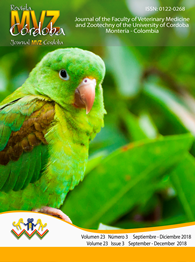Assessment of homeopathic medicines on survival and antioxidant response in white shrimp Litopenaeus vannamei
Evaluación de medicamentos homeopáticos en la supervivencia y respuesta antioxidante del camarón blanco Litopenaeus vannamei infectado con Vibrio parahaemolyticus
How to Cite
Mazón-Suástegui, J., García-Bernal, M., Avilés-Quevedo, M. A., Campa-Córdova, Ángel, Salas-Leiva, J., & Abasolo-Pacheco, F. (2018). Assessment of homeopathic medicines on survival and antioxidant response in white shrimp Litopenaeus vannamei. Journal MVZ Cordoba, 23(3), 6850-6859. https://doi.org/10.21897/rmvz.1373
Dimensions
Show authors biography
Article visits 2921 | PDF visits
Downloads
Download data is not yet available.
- Valdez G, Díaz F, Re AD, Sierra E. Efecto de la salinidad sobre la fisiología energética del camarón blanco Litopenaeus vannamei (Boone). Hidrobiológica 2008; 18(2):105-115.
- Soto-Rodriguez SA, Gomez-Gil B, Lozano-Olvera R, Betancourt-Lozano M, Morales-Covarrubias MS 2015. Field and experimental evidence of Vibrio parahaemolyticus as the causative agent of acute hepatopancreatic necrosis disease (AHPND) of cultured shrimp (Litopenaeus vannamei) in northwestern Mexico. Appl Environ Microbiol. 81(5): 1689-1699. https://doi.org/10.1128/AEM.03610-14
- Schryver PD, Defoirdt T, Sorgeloos P. Early mortality syndrome outbreaks: a microbial management issue in shrimp farming? PLoS Pathog 2014; 10(4): e1003919 https://doi.org/10.1371/journal.ppat.1003919
- Newaj-Fyzul A, Austin B. Probiotics, immunostimulants, plant products and oral vaccines, and their role as feed supplements in the control of bacterial fish diseases. J Fish Dis 2015; 38(11):937-955. https://doi.org/10.1111/jfd.12313
- Lakshmi B, Viswanath B, Sai Gopal DVR. Probiotics as antiviral agents in shrimp aquaculture. J Pathog. 2013; Article ID 424123.
- Standen BT, Rawling MD, Davies SJ, Castex M, Foey A, Gioacchini G. Probiotic Pediococcus acidilactici modulates both localised intestinal- and peripheral-immunity in tilapia (Oreochromis niloticus). Fish Shellfish Immun 2013; 35(4):1097-1104. https://doi.org/10.1016/j.fsi.2013.07.018
- Ortiz-Cornejo NL, Tovar-Ramírez D, Abasolo-Pacheco F, Mazón-Suástegui JM. Homeopatía, una alternativa para la acuicultura. Rev Med Homeopat 2017; 10(1):18-24. https://doi.org/10.1016/j.homeo.2017.04.006
- Khuda-Bukhsh AR, Pathak S. Homeopathic drug discovery: theory update and methodological aspect. Expert Opinion on Drug Discovery 2008; 3(8):979-990. https://doi.org/10.1517/17460441.3.8.979
- Vockeroth WG. Veterinary homeopathy: an overview. The Can Vet J 1999; 40:592.
- Siena CE, Natali MRM, Braccini GL, Oliveira AC, Ribeiro RP, Vargas L. Effect of core homeopathic homeopatila 100® in productive efficiency of fingerlings reverted from Nile tilapia (Oreochromis niloticus). Semina: Ciênc Agrár 2010; 31(4):985–994. https://doi.org/10.5433/1679-0359.2010v31n4p985
- Luis-Villase-or IE, Voltolina D, Gomez-Gil B, Ascencio F, Campa-Córdova ÁI, Audelo-Naranjo JM, Zamudio-Armenta OO. Probiotic modulation of the gut bacterial community of juvenile Litopenaeus vannamei challenged with Vibrio parahaemolyticus CAIM 170. Lat Am J of Aquat Res 2015; 43(4):766-775.
- Takahashi Y, Itami T, Kondo M, Maeda M, Fujii R, Tomonaga S, Supamattaya K., Boonayaratpalin S. Electron microscopic evidence of bacilliform virus infection in kuruma shrimp (Penaeus japonicus). Fish Pathology 1994; 29:121-125. https://doi.org/10.3147/jsfp.29.121
- Roque A, Gómez-Gil B, Guerra Flores AL. Standardization of three techniques for experimental Vibrio infections in the marine shrimp Penaeus vannamei. In Flegel TW (ed) Advances in shrimp biotechnology. National Center for Genetic Engineering and Biotechnology, Bangkok. 1998.
- Finney DJ. Probit analysis: a statistical treatment of the sigmoid response curve. 2nd edn. Cambridge University Press; Cambridge: 1952.
- Dudonné S, Vitrac X, Coutière P, Woillez M, Mérillon JM. Comparative study of antioxidant properties and total phenolic content of 30 plant extracts of industrial interest using DPPH, ABTS, FRAP, SOD, and ORAC assays. J Agric Food Chem 2009; 57(5):1768-1774. https://doi.org/10.1021/jf803011r
- Mazón-Suástegui JM, García-Bernal M, Saucedo PE, Campa-Córdova Á, Abasolo-Pacheco F. Homeopathy outperforms antibiotics treatment in juvenile scallop Argopecten ventricosus: effects on growth, survival, and immune response. Homeopathy 2017; 106(1):18-26. https://doi.org/10.1016/j.homp.2016.12.002
- Merlini LS, Vargas L, Piau R, Ribeiro PR, Merlini NB. Effects of a homeopathic complex on the performance and cortisol levels in Nile tilapia (Oreochromis niloticus). Homeopathy 2014; 103:139–142. https://doi.org/10.1016/j.homp.2013.08.005
- Gómez B, Roque A, Guerra AL. (). Enfermedades Infecciosas más comunes en la camaronicultura en México y el impacto del uso de antimicrobianos. Instituto de Ciencias del Mar y Limnología; México: 2001.
- Saulnier D, Haffner P, Goarant C, Levy P, Ansquer D. Experimental infection models for shrimp vibriosis studies: a review. Aquaculture 2000; 191:133-144. https://doi.org/10.1016/S0044-8486(00)00423-3
- Aguirre-Guzmán G, Sánchez-Martínez JG, Pérez-Casta-eda R, Palacios-Monzón A, Trujillo-Rodríguez T, De La Cruz-Hernández NI. Pathogenicity and Infection Route of Vibrio parahaemolyticus in American White Shrimp, Litopenaeus vannamei. J World Aquac Soc 2010; 41: 464–470. https://doi.org/10.1111/j.1749-7345.2010.00388.x
- Lemaitre B, Hoffmann J. The host defense of Drosophila melanogaster. Annu Rev Immunol 2007; 25:697-743. https://doi.org/10.1146/annurev.immunol.25.022106.141615
- Fridovich I. Oxygen toxicity: a radical explanation. J Exp Biol 1998; 201:1203-1209.
- Franco, R., Martín, L., Arenal, A., Santiesteban, D., Sotolongo, J., Cabrera, H., Castillo, N. M. Evaluation of two probiotics used during farm production of white shrimp Litopenaeus vannamei (Crustacea: Decapoda). Aquac Res 2017; 48(4):1936-1950. https://doi.org/10.1111/are.13031
- Liu, G., Zhu, S., Liu, D., Guo, X., Ye, Z. Effects of stocking density of the white shrimp Litopenaeus vannamei (Boone) on immunities, antioxidant status, and resistance against Vibrio harveyi in a biofloc system. Fish Shellfish Immun 2017; 67:19-26. https://doi.org/10.1016/j.fsi.2017.05.038
- Díaz-García A, Morier-Díaz L, Frión-Herrera Y, Rodríguez-Sánchez H, Caballero-Lorenzo Y, Mendoza-Llanes D, Riquenes-Garlobo Y, Fraga-Castro JA. In vitro anticancer effect of venom from Cuban scorpion Rhopalurus junceus against a panel of human cancer cell lines. J Venom Res 2013; 4:5-12.
- Díaz A, Morier L, Rodríguez H, Caballero Y. Citotoxicidad del veneno del escorpión cubano Rhopalurus junceus y sus fracciones sobre líneas celulares tumorales humanas. LABIOFAM 2010; 1:12-18.
- Hernández Betancourt O, Casado Hernández I, Iglesias Huerta E, Ramírez Labrada A, Del Risco Ramos J, Rodríguez Pargas A. Evaluación de la toxicidad in vitro del veneno del alacrán Rhopalurus junceus a través de un ensayo celular. Rev Cubana de Invest Bioméd 2009; 28(1):1-11.
- Akazawa N, Eguchi M. Environmental trigger for EMS/ AHPNS identified in Agrobest shrimp ponds. Glob Aquacult Advocate 2013; 4:16-17.
- Hoanh DTH, Phu TQ, Phuong NT, Tuan PA. Ongoing Vietnam studies find Vibrio with phage transmits EMS/AHPNS. Glob Aquacult Advocate 2013; 4:22-23.
























